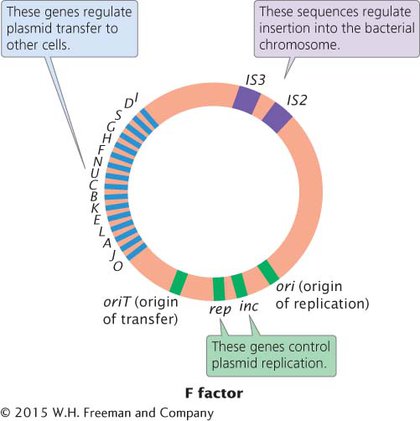Plasmids
In addition to having a chromosome, many bacteria possess plasmids: small, usually circular DNA molecules. Some plasmids are present in many copies per cell, whereas others are present in only one or two copies. In general, plasmids carry genes that are not essential to bacterial function but may play an important role in the life cycle and growth of their bacterial hosts. There are many different types of plasmids; E. coli alone is estimated to have more than 270 different naturally occurring plasmids. Some plasmids promote mating between bacteria; others produce compounds that kill other bacteria. Plasmids are used extensively in genetic engineering (see Chapter 14), and some of them play a role in the spread of antibiotic resistance among bacteria.
Most plasmids are circular and several thousand base pairs in length, although plasmids consisting of several hundred thousand base pairs have also been found. Each plasmid possesses an origin of replication, a specific DNA sequence where DNA replication is initiated (see Chapter 2). The origin allows a plasmid to replicate independently of the bacterial chromosome (Figure 7.5). Episomes are plasmids that are capable of replicating freely and are able to integrate into the bacterial chromosomes. The F (fertility) factor of E. coli (Figure 7.6) is an episome that controls mating and gene exchange between E. coli cells, a process we will discuss shortly.


CONCEPTS
Bacteria can be studied in the laboratory by growing them on liquid or solid media. A typical bacterial genome consists of a single circular chromosome that contains several million base pairs. Some bacterial genes may be present on plasmids, which are small, circular DNA molecules that replicate independently of the bacterial chromosome.
 CONCEPT CHECK 1
CONCEPT CHECK 1
Which of the following statements is true of plasmids?
They are composed of RNA.
They normally exist outside of bacterial cells.
They possess only a single strand of DNA.
They contain an origin of replication.
d